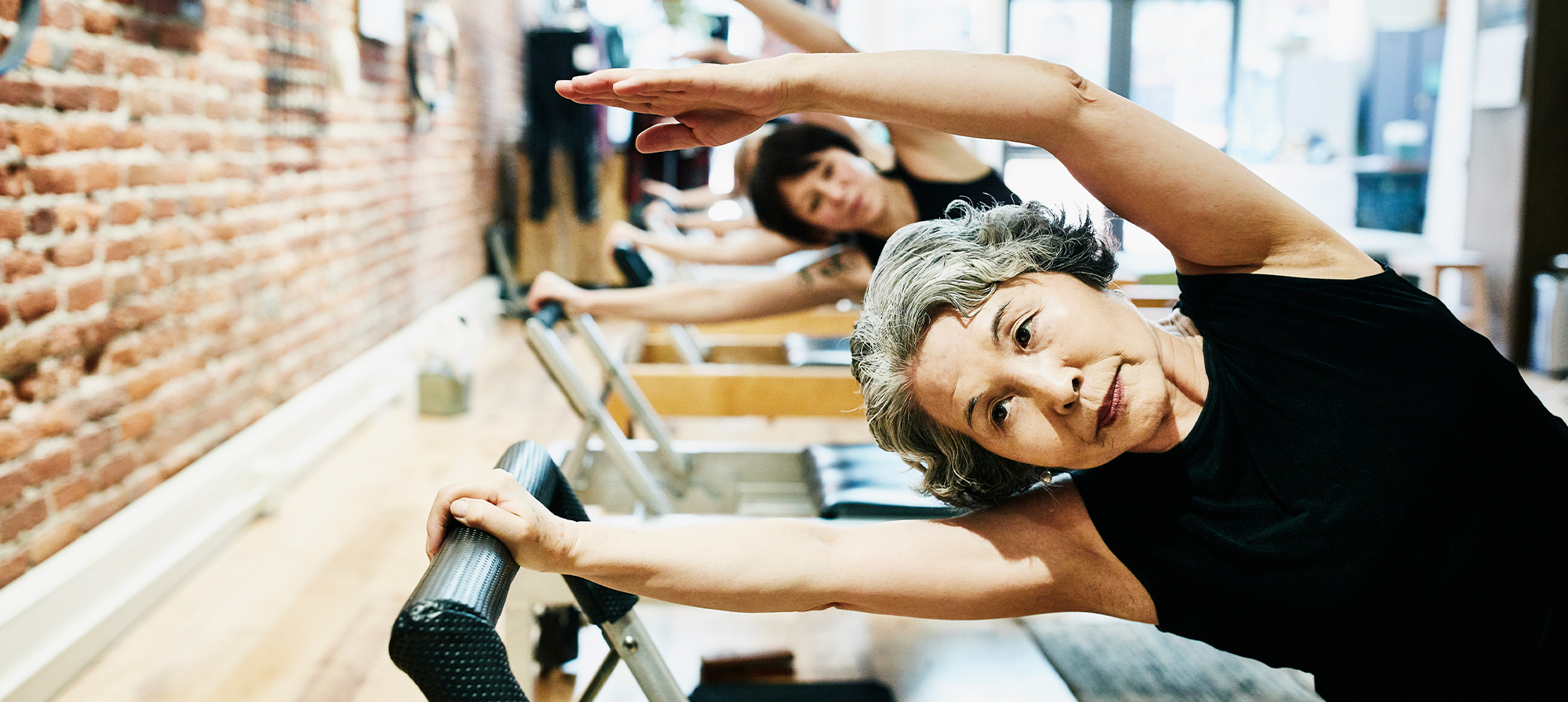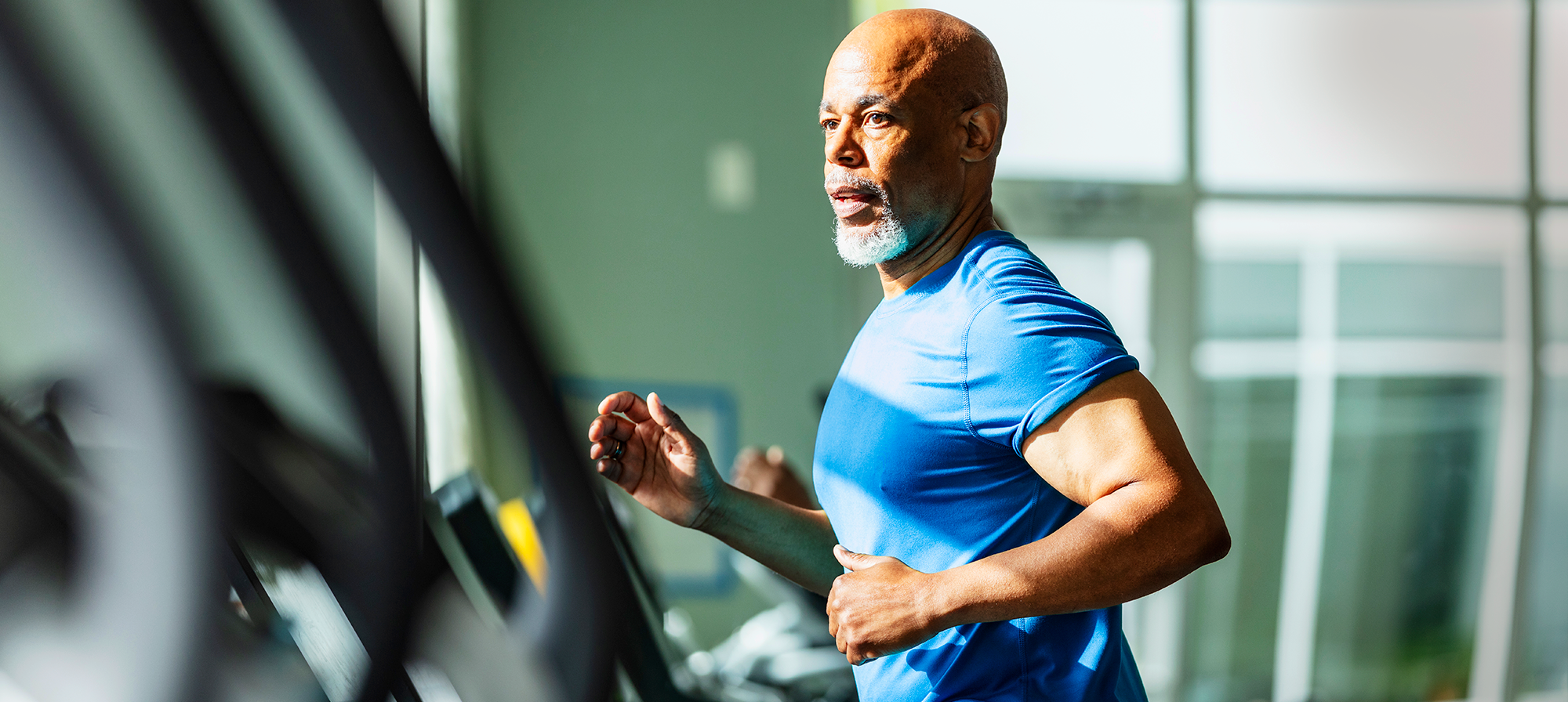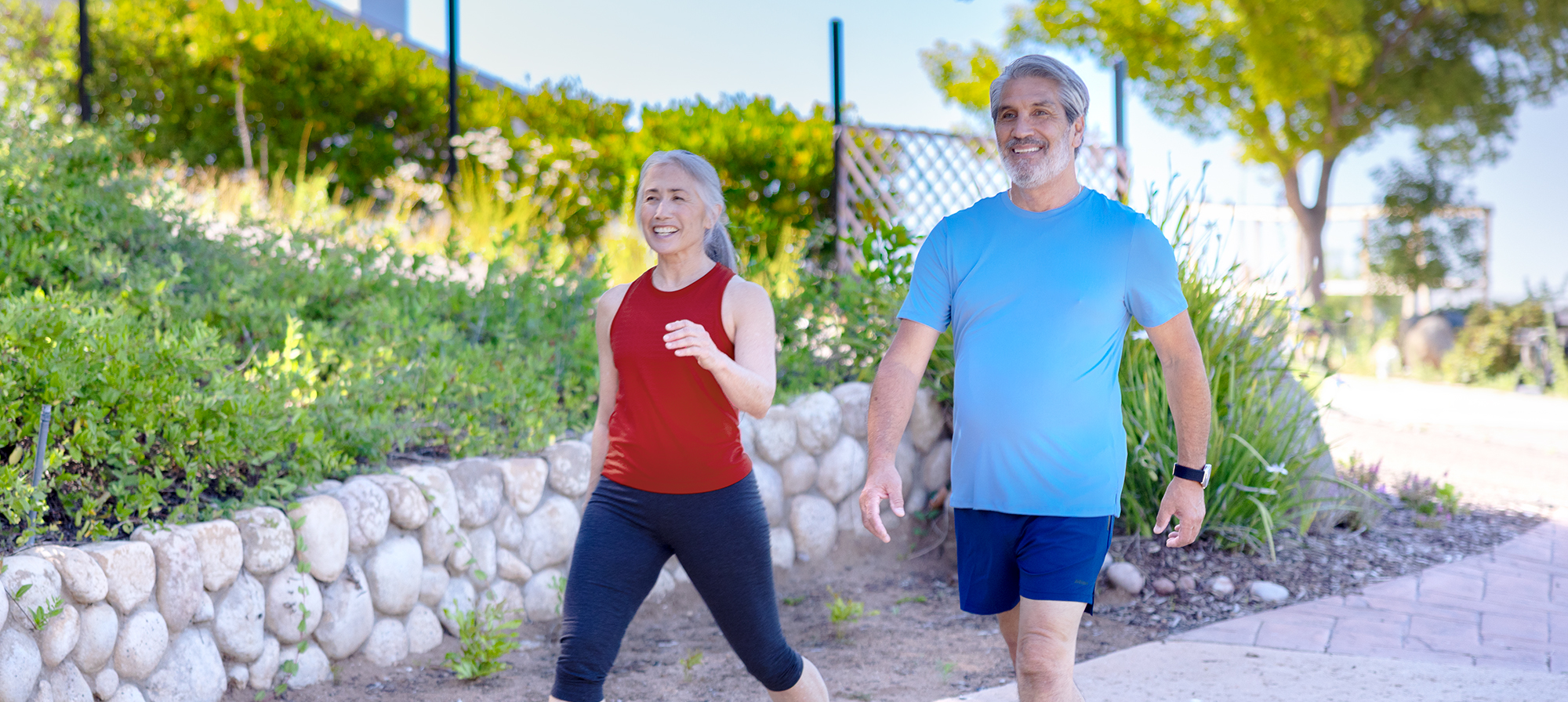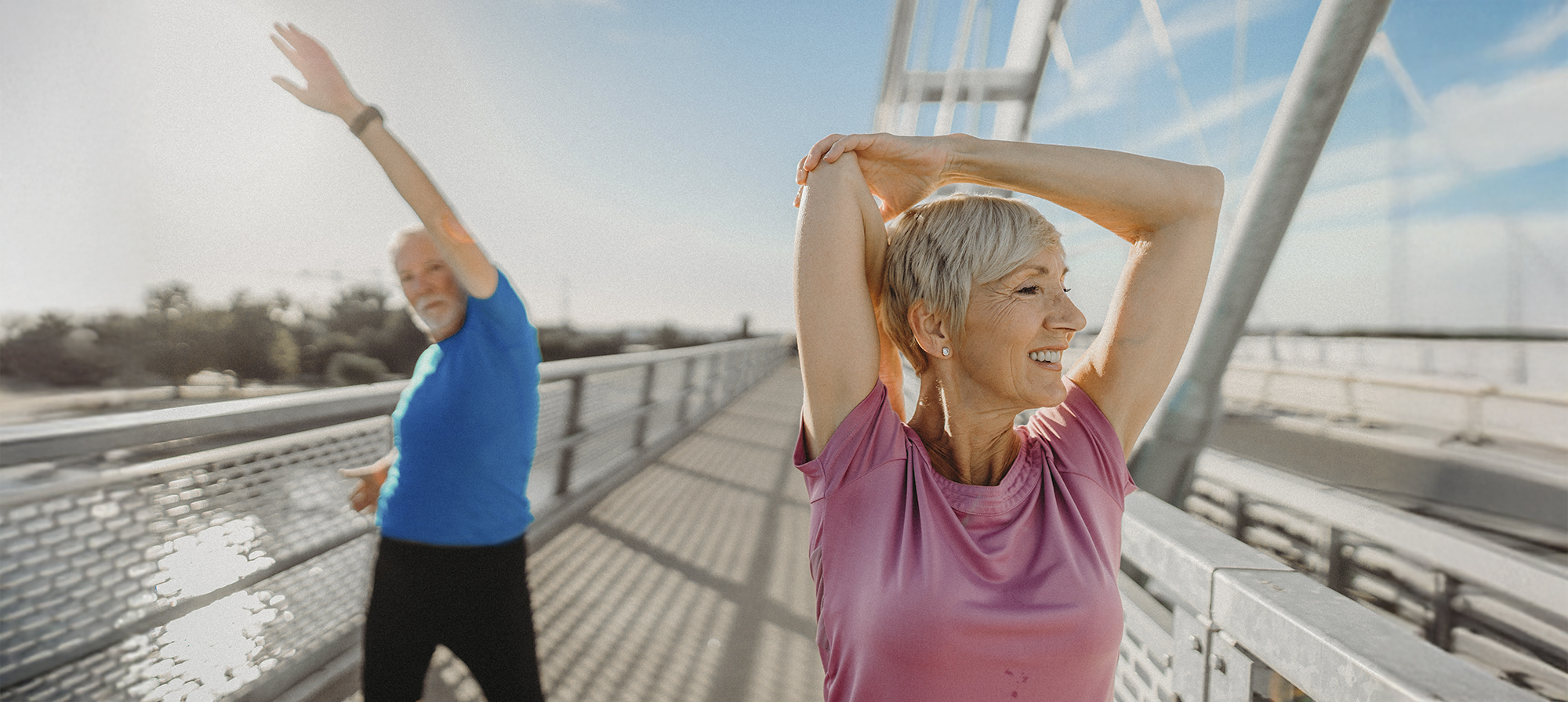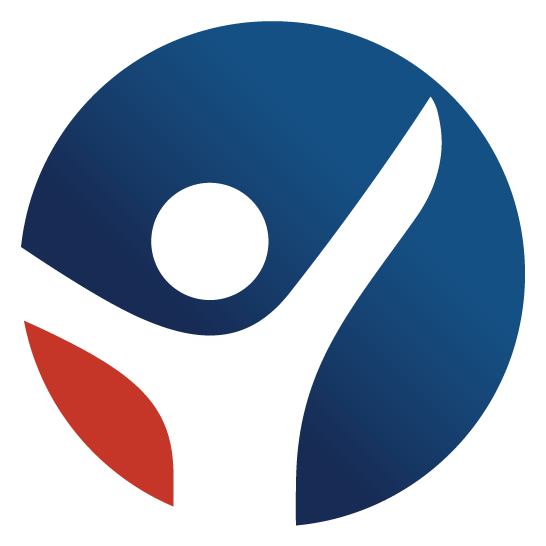Once a little-known, niche training method for dancers, Pilates has become a widespread, popular fitness trend in recent decades. Here’s why it’s still popular today.
Pilates (pronounced puh-lah-teez) is a whole-body, low-impact training method that offers a wide range of health and fitness perks. This practice integrates both the body and mind. It's where mindfulness and exercise come together to form a satisfying workout.
Pilates uses deep concentration with slow, controlled, precise movements to bolster fitness levels and mental focus. Its use of breathwork can also help ease stress and boost mood and well-being.
Here's a closer look at what Pilates is, where it came from, what makes it unique—and why it has remained popular for decades.
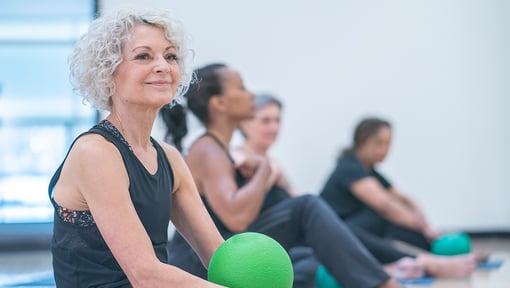
Pilates – how it all started
Joseph H. Pilates—the founder of the Pilates method—was born in Germany in 1883. Influenced by his very athletic, fitness-and-sports-enthusiast father, Joseph took a keen interest in health and fitness at an early age. This led him to become a life-long athlete and fitness enthusiast, as well as a trainer.
As an adult, Joseph moved to England in 1913, where he performed as a circus acrobat. When World War I broke out a year later, he became a prisoner of war. It was in the prison camp that he began to develop his training method. He led the daily fitness sessions for his fellow prisoners. At the same time, he started to explore and create exercises to help soldiers recover from their injuries.
Besides his work with injured soldiers, Joseph was influenced by many holistic therapies just starting to take root in Europe after World War I. These included breath work, hydrotherapy, trigger point therapy, modern dance, and meditation.
It was during this time that Joseph created a device designed to help condition the body, address dysfunction, and foster injury recovery. This early model eventually became a staple piece of equipment used in Pilates training today—the Universal Reformer. Now called the Pilates Reformer , it’s a moveable platform with springs, pulleys, straps, and cables that looks something like a bed frame.
Joseph immigrated to the United States in 1926, where he met and married his wife, Clara. Together, they opened the Pilates Universal Gymnasium in New York City in 1929. Joseph and Clara continued to evolve the Pilates training method over the years, working closely with members of the New York City dance community.
Many of these dancers became Pilates teachers, who, in turn, would train the next generation of teachers. That group eventually brought Pilates to other parts of the U.S. and the world during the 1970s, 80s, and 90s. Now, over 100 years later, Pilates remains a highly popular form of fitness training.
 What is Pilates and how does it work?
What is Pilates and how does it work?
Pilates consists of slow, controlled movements against resistance. Your own body weight can provide that resistance. Or it can come from specialized machines with springs, pulleys, and cables, including the Reformer table. Some Pilates studios offer mat classes, which focus on bodyweight exercises. Other studios offer classes using the Reformer and other equipment. Some offer a combination of both.
Pilates uses a wide range of movements and exercises to strengthen and stretch your body. The workouts can be tailored to meet all levels of fitness. They can also be designed for people with health problems and injuries.
Pilates can help you reach a wide array of fitness goals. It conditions the body to help prevent injuries, but it also facilitates recovery from them. Plus, it’s a form of cross-training that can provide a foundation for other kinds of workouts. For example, if you want to start or intensify a weight-lifting routine, are training for a race, or want to take up a sport—Pilates can help get you in baseline shape for these activities. It can also enhance your performance when doing other workouts.
These are just a few of the many health and fitness perks Pilates offers. Also, keep in mind that—as with any new fitness routine—it’s a good idea to talk with your doctor before starting Pilates training. This is especially important if you have any health conditions, such as osteoporosis or joint or spine injuries.

Core principles of Pilates
Pilates training also relies on a handful of core principles as its foundation. Some of these are:
- Center alignment (from your core)
- Concentration
- Control
- Precision
- Fluidity of movement
- Breathing
Other unique traits of Pilates training:
- It targets the deep muscles that move your spine, core, and joints while providing their foundational stability.
- It helps elongate your body and fosters better coordination between all its parts, so your movements flow smoothly from one to another.
- It enhances body awareness. This can help you tune into places in your body where you may be holding extra tension. Greater body awareness can also help you feel more centered, stable, and confident as you move through space.
It’s no wonder dancers still flock to Pilates training to this day!

Wait…there’s more
Pilates isn’t just for dancers, though. Anyone can reap the health and fitness perks it offers—no matter their age or fitness level. Pilates can help you:
- Develop overall strength. The resistance exercises in Pilates work the muscles of the whole body—including the arms, legs, back, shoulders, chest, and core. This strength training aspect of Pilates can help build and maintain muscle mass and strong bones. It also helps boost metabolism, mood, and the ability to perform daily activities with greater ease.
- Build core strength. Pilates training has a keen focus on the core—or the trunk of your body. Your core is what connects and helps coordinate the movements of your upper body with your lower body. It supports your spine. Your core is made up of the sides of your trunk, your mid- and lower back, your abdomen, your hips, and your pelvic floor. Pilates training targets the deep core muscles that attach to your spinal column, as well as the more superficial muscles, for a truly optimal core-strengthening workout.
- Improve balance. Core and leg strength help you keep your balance—whether you’re in motion or standing still. Pilates has also been shown to improve gait (your ability to walk quickly and well). Both of these fitness gains can help prevent falls.
- Develop better posture. The core strengthening in Pilates helps foster a strong, stable, and healthy posture. Good posture, in turn, helps prevent back and neck pain.
- Boost flexibility and mobility. Because Pilates workouts weave in a lot of stretching, they can boost flexibility and, thus, your range of motion in your joints.
- Enhance functional fitness. The boost in strength, mobility, and coordination Pilates provides can improve functional fitness. This is the ability to perform daily activities more easily and safely—whether you’re sweeping the floor, pulling a bag of groceries out of the car, hitting a tennis ball, or doing anything that calls for you to reach, lunge, bend, lift, etc.
- Ease pain. With its focus on core strength and stable posture—along with enhanced flexibility, overall strength, and joint mobility—Pilates may help lessen pain, including back pain.
- Protect bone health. Pilates is not a high-impact exercise—the kind that helps increase and maintain bone mineral density (bone strength). Yet strengthening the muscles around your spine and joints may help, along with high-impact exercise, to keep your bones strong. However, if you already have osteoporosis, there are certain Pilates movements you may want to avoid, such as any that curve (flex) or twist your spine.
- Improve mental and emotional well-being. Research suggests Pilates can give you a greater sense of your own health and fitness. It supports greater quality of life, boosts mood, lowers stress, and may lessen the risk of anxiety and depression. Its focused breathing and mental concentration can help induce calm and boost mental discipline.

Getting started with Pilates
Here are some steps you can take to establish a Pilates training routine:
- Talk with your doctor before you start Pilates training, or any other exercise program, to make sure it’s safe for you. If you have any injuries, osteoporosis, or other health condition, ask your doctor if Pilates is a safe choice. You may want to work with a Pilates trainer one-on-one, who can tailor your sessions to your needs.
- Pick your Pilates pleasure. There is a wide array of Pilates classes you can choose from. Look for a Pilates studio with classes run by certified Pilates teachers. Or think about trying an online class. Other options to choose from include:
- Mat class. Bodyweight and stretching exercises are performed on a yoga mat.
- Reformer class. These training sessions consist of exercises using the Reformer and other equipment.
- Combo class. Pilates sessions with exercises done on both a yoga mat and a Reformer.
- Private sessions. Working one-on-one with a Pilates instructor, in either a mat class, Reformer class, or combo class.
- Group classes. These will likely be less costly than private sessions. Find a small class if you can, especially when starting out. The trainer can spend more time helping each student with a smaller class size.
- Classical Pilates. These training sessions use only the exercises developed by Joseph and Clara Pilates.
- Modern Pilates. These classes include a fusion of Pilates and some other types of training, often yoga.
Think about doing a Pilates class one or two times per week. Keep in mind that fitness experts suggest that Pilates training should not be the only form of exercise you do. Rather, it should augment your other workouts—including cardio and strength training sessions you do each week. So, give it a try! Weave a few Pilates sessions into your weekly workout routine and watch the fitness gains roll in.
Not a Silver&Fit® member? Learn more about everything the program has to offer, including more helpful healthy living tips like this, here on our website.
This information is not intended to take the place of regular medical care or advice. Please check with your doctor before using this information or beginning any self-care program. Images used for this article do not depict any members of the Silver&Fit program.
References
American Council on Exercise. (2022, October 6). Pilates, health benefits, how to get started, how to get better (Everyday Health). https://www.acefitness.org/about-ace/press-room/in-the-news/8174/pilates-health-benefits-how-to-get-started-and-how-to-get-better-everyday-health/?srsltid=AfmBOopIJYamFD_TLv1mJx7CRtf8XTSQeuiyGGUC0HMRF6YaRbKRbbJC
Byrnes, K., Wu, P. J., Whillier, S. (2018). Is Pilates an effective rehabilitation tool? A systematic review. Journal of Bodywork and Movement Therapies, 22(1):192-202. https://www.doi: 10.1016/j.jbmt.2017.04.008
Cleveland Clinic. (2023, March 10). Pilates 101: What it is and health benefits. https://health.clevelandclinic.org/everything-you-want-to-know-about-pilates
de Almeida, P. P., de Oliveira, R. G., de Almeida, L. I. M., de Oliveira, L. C. (2024). Effects of Pilates exercises on health-related quality of life in postmenopausal women: A systematic review and meta-analysis. Quality of Life Research, 33(8):2067-2079. https://www.doi: 10.1007/s11136-024-03651-x
Denham-Jones, L., Gaskell, L., Spence, N., Pigott, T. (2021) A systematic review of the effectiveness of Pilates on pain, disability, physical function, and quality of life in older adults with chronic musculoskeletal conditions. Musculoskeletal Care, 20(1):10-30. https://www.doi: 10.1002/msc.1563
Lin. H. T., Hung, W. C., Hung, J. L., Wu, P.S., Liaw, L. J., Chang, J.H. (2016). Effects of Pilates on patients with chronic non-specific low back pain: A systematic review. Journal of Physical Therapy Science, 28(10):2961-2969. https://www.doi: 10.1589/jpts.28.2961
Newell, T. (2024, January 3). 6 reasons to start Pilates at any age. AARP. https://www.aarp.org/health/healthy-living/info-2024/pilates-wellness-benefits.html
Pereira, M. J., Mendes, R., Mendes, R. S., Martins, F., Gomes, R., Gama, J., Dias, G., Castro, M. A. (2022). Benefits of Pilates in the elderly population: A systematic review and meta-analysis. European Journal of Investigation in Health, Psychology, and Education,12(3):236-268. https://www.doi: 10.3390/ejihpe12030018
Pilates Method Alliance. (n.d.) A beginner’s guide to Pilates equipment: From Reformer, to Cadillac, and beyond. https://www.pilatesmethodalliance.org/pma-blog/beginners-guide-to-pilates-equipment-from-reformer-to-cadillac-and-beyond-ptk3h-wefkb-4zr2w-df5ff-789hg
Pilates Method Alliance. (n.d.). The history of Pilates. https://nationalpilatescertificationprogram.org/PMA/PMA/About/History-of-Pilates.aspx
Pilates Method Alliance. (n.d.). Mastering functional fitness: How Pilates brings balance to everyday life. https://www.pilatesmethodalliance.org/pma-blog/span-classsqsrte-text-color-accentmastering-functional-fitness-how-pilates-brings-balance-to-everyday-lifespan-ygsjs-zke6r-9n4nz-sn4tk-scx7p#
Roller, M., Kachingwe, A., Beling, J., Ickes, D. M., Cabot, A., Shrier, G. (2018). Pilates Reformer exercises for fall risk reduction in older adults: A randomized controlled trial. Journal of Bodywork and Movement Therapies, 22(4):983-998. https://www.doi: 10.1016/j.jbmt.2017.09.004
Sommadossi, C. (n.d.) Pilates and mental well-being: The mind-body connection. Pilates Method Alliance. https://www.pilatesmethodalliance.org/pma-blog/pilates-amp-mental-well-being-the-mind-body-connection-9tbfy-e8lmj-gbhms-3nc9f-5ncjk#
Sommadossi, C. (n.d.). Why athletes love Pilates: Boosting performance and reducing injuries. Pilates Method Alliance. https://www.pilatesmethodalliance.org/pma-blog/why-athletes-love-pilates-boosting-performance-amp-reducing-injuries-kepx5-b4f39-s7e56-z8sy6-gcl8p#
Tolnai, N., Szabó, Z., Köteles, F., Szabo, A. Physical and psychological benefits of once-a-week Pilates exercises in young sedentary women: A 10-week longitudinal study. Physiology and Behavior, 163: 211-218. https://www.doi: 10.1016/j.physbeh.2016.05.025
University of California, Los Angeles. (2024, September 11). Four benefits of Pilates for older adults. https://www.uclahealth.org/news/article/4-benefits-pilates-older-adults
This article was written by Gail Olson, edited by Celina Johnson, and clinically reviewed by Jaynie Bjornaraa, PhD, MPH, PT, SCS, LAT, ATC, CSCS, CSPS, on March 8, 2025.
